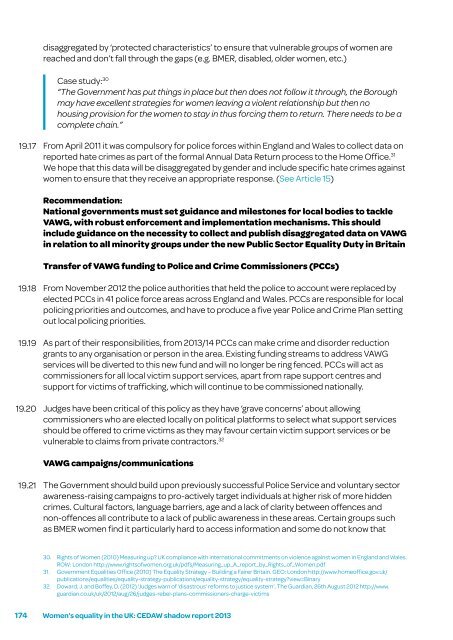Women’s equality in the UK – A health check
Women’s equality in the UK – A health check
Women’s equality in the UK – A health check
Create successful ePaper yourself
Turn your PDF publications into a flip-book with our unique Google optimized e-Paper software.
19.17<br />
19.18<br />
19.19<br />
19.20<br />
19.21<br />
disaggregated by ‘protected characteristics’ to ensure that vulnerable groups of women are<br />
reached and don’t fall through <strong>the</strong> gaps (e.g. BMER, disabled, older women, etc.)<br />
Case study: 30<br />
“The Government has put th<strong>in</strong>gs <strong>in</strong> place but <strong>the</strong>n does not follow it through, <strong>the</strong> Borough<br />
may have excellent strategies for women leav<strong>in</strong>g a violent relationship but <strong>the</strong>n no<br />
hous<strong>in</strong>g provision for <strong>the</strong> women to stay <strong>in</strong> thus forc<strong>in</strong>g <strong>the</strong>m to return. There needs to be a<br />
complete cha<strong>in</strong>.”<br />
From April 2011 it was compulsory for police forces with<strong>in</strong> England and Wales to collect data on<br />
reported hate crimes as part of <strong>the</strong> formal Annual Data Return process to <strong>the</strong> Home Office. 31<br />
We hope that this data will be disaggregated by gender and <strong>in</strong>clude specific hate crimes aga<strong>in</strong>st<br />
women to ensure that <strong>the</strong>y receive an appropriate response. (See Article 15)<br />
Recommendation:<br />
National governments must set guidance and milestones for local bodies to tackle<br />
VAWG, with robust enforcement and implementation mechanisms. This should<br />
<strong>in</strong>clude guidance on <strong>the</strong> necessity to collect and publish disaggregated data on VAWG<br />
<strong>in</strong> relation to all m<strong>in</strong>ority groups under <strong>the</strong> new Public Sector Equality Duty <strong>in</strong> Brita<strong>in</strong><br />
Transfer of VAWG fund<strong>in</strong>g to Police and Crime Commissioners (PCCs)<br />
From November 2012 <strong>the</strong> police authorities that held <strong>the</strong> police to account were replaced by<br />
elected PCCs <strong>in</strong> 41 police force areas across England and Wales. PCCs are responsible for local<br />
polic<strong>in</strong>g priorities and outcomes, and have to produce a five year Police and Crime Plan sett<strong>in</strong>g<br />
out local polic<strong>in</strong>g priorities.<br />
As part of <strong>the</strong>ir responsibilities, from 2013/14 PCCs can make crime and disorder reduction<br />
grants to any organisation or person <strong>in</strong> <strong>the</strong> area. Exist<strong>in</strong>g fund<strong>in</strong>g streams to address VAWG<br />
services will be diverted to this new fund and will no longer be r<strong>in</strong>g fenced. PCCs will act as<br />
commissioners for all local victim support services, apart from rape support centres and<br />
support for victims of traffick<strong>in</strong>g, which will cont<strong>in</strong>ue to be commissioned nationally.<br />
Judges have been critical of this policy as <strong>the</strong>y have ‘grave concerns’ about allow<strong>in</strong>g<br />
commissioners who are elected locally on political platforms to select what support services<br />
should be offered to crime victims as <strong>the</strong>y may favour certa<strong>in</strong> victim support services or be<br />
vulnerable to claims from private contractors. 32<br />
VAWG campaigns/communications<br />
The Government should build upon previously successful Police Service and voluntary sector<br />
awareness-rais<strong>in</strong>g campaigns to pro-actively target <strong>in</strong>dividuals at higher risk of more hidden<br />
crimes. Cultural factors, language barriers, age and a lack of clarity between offences and<br />
non-offences all contribute to a lack of public awareness <strong>in</strong> <strong>the</strong>se areas. Certa<strong>in</strong> groups such<br />
as BMER women f<strong>in</strong>d it particularly hard to access <strong>in</strong>formation and some do not know that<br />
30. Rights of Women (2010) Measur<strong>in</strong>g up? <strong>UK</strong> compliance with <strong>in</strong>ternational commitments on violence aga<strong>in</strong>st women <strong>in</strong> England and Wales.<br />
ROW: London http://www.rightsofwomen.org.uk/pdfs/Measur<strong>in</strong>g_up_A_report_by_Rights_of_Women.pdf<br />
31. Government Equalities Office (2010) The Equality Strategy <strong>–</strong> Build<strong>in</strong>g a Fairer Brita<strong>in</strong>. GEO: London http://www.homeoffice.gov.uk/<br />
publications/equalities/<strong>equality</strong>-strategy-publications/<strong>equality</strong>-strategy/<strong>equality</strong>-strategy?view=B<strong>in</strong>ary<br />
32. Doward, J. and Boffey, D. (2012) ‘Judges warn of ‘disastrous’ reforms to justice system’, The Guardian, 26th August 2012 http://www.<br />
guardian.co.uk/uk/2012/aug/26/judges-rebel-plans-commissioners-charge-victims<br />
174 <strong>Women’s</strong> <strong>equality</strong> <strong>in</strong> <strong>the</strong> <strong>UK</strong>: CEDAW shadow report 2013


